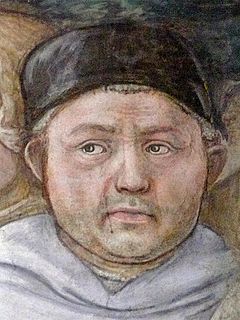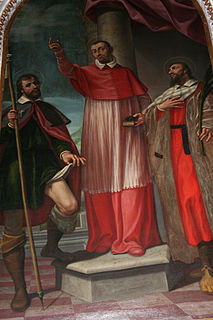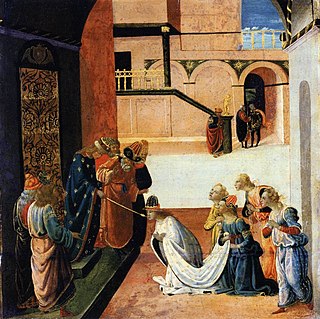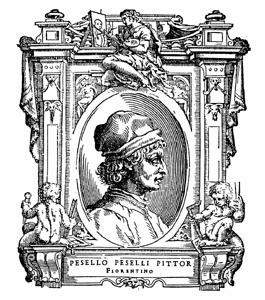
Domenico di Michelino (1417–1491) was an Italian Renaissance painter who was born and died in Florence. His real name was Domenico di Francesco. The patronymic "di Michelino" was adopted in honor of his teacher, the cassone painter Michelino di Benedetto, by whom no works have been identified. Giorgio Vasari reports that Domenico was also a pupil of Fra Angelico, whose influence is reflected in many of Domenico's paintings along with that of Filippo Lippi and Pesellino.

Fra'Filippo Lippi, also known as Lippo Lippi, was an Italian painter of the Quattrocento and a Carmelite Priest.

Giovanni Santi was an Italian painter, decorator, and the father of Raphael. He was born in 1435 at Colbordolo in the Duchy of Urbino. He studied under Piero della Francesca and was influenced by Fiorenzo di Lorenzo. He was court painter to the Duke of Urbino and painted several altarpieces. He died in Urbino.
Giuliano di Piero di Simone Bugiardini was an Italian Renaissance painter. He was born and was mainly active in Florence. He was a painter primarily of religious subjects but he also executed a number of portraits and a few works with mythological subjects.

Giovanni Paolo Cavagna was an Italian painter of the late-Renaissance period, active mainly in Bergamo and Brescia.
Events from the year 1506 in art.

Giuseppe Nicola Nasini was an Italian painter of the Baroque period, active in Rome and Tuscany.

Jacopo del Sellaio (1441/2–1493), was an Italian painter of the early Renaissance, active in his native Florence. His real name was Jacopo di Arcangelo. He worked in an eclectic style based on those of Botticelli, Filippino Lippi, and Domenico Ghirlandaio. The nickname Sellaio derives from the profession of his father, a saddle maker.

Jacques Goudstikker was a Jewish Dutch art dealer who fled the Netherlands when it was invaded by Nazi Germany during World War II, leaving three furnished properties and an extensive and significant art collection including over 1200 paintings, many of which had been previously catalogued as "Old Masters". The entire collection, which had been surveyed by Hermann Goering himself, was subsequently looted by the Nazis. Between the two World Wars, Jacques Goudstikker had been the most important Dutch dealer of Old Master paintings, according to Peter C. Sutton, executive director and CEO of the Bruce Museum of Arts and Science. Despite efforts of Goudstikker's widow after the war to regain possession of the collection, it was not until after her death that the Dutch government finally restituted 202 paintings to the Goudstikker family in 2006. To finance efforts to reclaim more of the stolen art, a large portion of them were sold at auction in 2007 for almost $10 million.

The Lives of the Most Excellent Painters, Sculptors, and Architects, often simply known as The Lives, is a series of artist biographies written by 16th-century Italian painter and architect Giorgio Vasari, which is considered "perhaps the most famous, and even today the most-read work of the older literature of art", "some of the Italian Renaissance's most influential writing on art", and "the first important book on art history".

Lorenzo di Bicci was an Italian painter of the Florentine School considered to be one of the most important painters in Florence during the second half of the 14th century. He is believed to have learned his trade from his father, about whom little is known. Lorenzo’s style, as well as that of his contemporaries Jacopo di Cione and Niccolò di Pietro Gerini, was influenced by the artist Andrea di Cione. Lorenzo's paintings made use of bright colors and his compositions avoided complexity. The figures he painted tended to have round faces and were often expressionless. Another one of Lorenzo's distinctive characteristics was his precision of execution. He was known for exceptional talent in drawing, an ability that he put to use at the initial stages of his painting. Unlike many celebrated Florentine artists of this period, Lorenzo mostly received commissions from the country clergy and from the lower-middle class Florentine guilds. His successors, Bicci di Lorenzo and Neri di Bicci, continued to serve these groups.

Francesco Pesellino, also known as Francesco di Stefano, was an Italian Renaissance painter active in Florence. His father was the painter Stefano di Francesco, and his maternal grandfather was the painter Giuliano Pesello (1367–1446), from whose name the diminutive nickname "Pesellino" arose. After the death of his father in 1427, the young Pesellino went to live with his grandfather whose pupil he became. Pesellino remained in his grandfather's studio until the latter's death, when he began to form working partnerships with other artists, such as Zanobi Strozzi and Fra Filippo Lippi. He married in 1442, and probably joined the Florentine painters' guild in 1447. In the following years he made for reputation with small, highly-finished works for domestic interiors, including religious panels for private devotional use and secular subjects for pieces of furniture.
Stefano di Francesco was an Italian (Florentine) painter, who probably died young, as he left a five-year-old son, and was outlived twenty years by his father-in-law, the painter Giuliano Pesello (1367–1446). His son was the painter Francesco Pesellino (1422–1457), the most distinguished of the three. Nothing is known of Stefano di Francesco's painting.

The Musée du Petit Palais is a museum and art gallery in Avignon, southern France. It opened in 1976 and has an exceptional collection of Renaissance paintings of the Avignon school as well as from Italy, which reunites many "primitives" from the collection of Giampietro Campana. It is housed in a 14th-century building at the north side of the square overlooked by the Palais des Papes. The building, built in the early 14th century as the residence of the bishops of Avignon, was made a UNESCO World Heritage Site as part of the historic center of Avignon in 1995.

Bartolomeo di Giovannidi Domenico (1458?-1501) was an Italian Renaissance painter active in Florence. His works were first identified by the art historian Bernard Berenson, who did not know the painter's real name so called him the "Alunno di Domenico". This name was based on Berenson's observation that the painter executed the predella of Ghirlandaio's Adoration of the Magi (1488) in the Ospedale degli Innocenti, the foundling hospital in Florence. Archival research later yielded the painter's real name as Bartolomeo di Giovanni. Bartolomeo also collaborated with Sandro Botticelli.

Ottaviano Nelli (1375–1444?) was an Italian painter of the early Quattrocento. Nelli primarily painted frescoes, but also panel paintings. He had several pupils and two painters were influenced by him.

Zanobi di Benedetto di Caroccio degli Strozzi, normally referred to more simply as Zanobi Strozzi, was an Italian Renaissance painter and manuscript illuminator active in Florence and nearby Fiesole. He was closely associated with Fra Angelico, probably as his pupil, as told by Vasari. He is the same painter as the Master of the Buckingham Palace Madonna. Most of his surviving works are manuscript illuminations but a number of panel paintings have also been attributed to him, including seven altarpieces and six panels with the Virgin and Child, along with some designs for metalwork.

The Master of Pratovecchio was an Italian painter of the Renaissance, named by Roberto Longhi in a 1952 article on the basis of stylistic similarities of a number of works to an altarpiece painted for the monastery of San Giovanni Evangelista in Pratovecchio. The centre panel of the triptych, depicting the Assumption of the Virgin is currently on deposit in Arrezo; the left and right side-panels are in the National Gallery, London.
Giovanni di Francesco del Cervelliera or Giovanni di Francesco was an Italian painter, active in Florence in the mid-fifteenth century.
Francesco da Castello was a Flemish-Italian painter and manuscript illuminator, active in Rome.



















